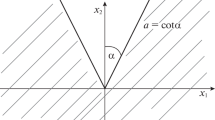Abstract
A certain conjugation problem for an elliptic pseudo-differential equation in a plane sector is studied in Sobolev–Slobodetskii spaces. Using wave factorization for an elliptic symbol with concrete index we consider Dirichlet and Neumann conditions on sector sides. It permits to reduce the considered boundary value problem to a system of one-dimensional linear integral equations. For a special case it is possible further to reduce the mentioned system to a system of linear algebraic equations with respect to \(8\) unknown functions.
Similar content being viewed by others
REFERENCES
L. Hörmander, Analysis of Partial Differential Operators (Springer, Berlin, 1983), Vols. I–IV.
M. Taylor, Pseudodifferential Operators (Princeton Univ. Press, Princeton, 1981).
F. Treves, Introduction to Pseudodifferential Operators and Fourier Integral Operators (Springer, New York, 1980).
S. Rempel and B.-W. Schulze, Index Theory of Elliptic Boundary Problems (Akademie, Berlin, 1982).
B.-W. Schulze, Boundary Value Problems and Singular Pseudo-Differential Operators (Wiley, Chichester, 1998).
S. A. Nazarov and B. A. Plamenevsky, Elliptic Problems in Domains with Piecewise Smooth Boundaries (Walter de Gruyter, Berlin, 1994).
G. Eskin, Boundar Value Problems for Elliptic Pseudodifferential Equations (AMS, Providence, RI, 1981).
V. S. Vladimirov, Methods of the Theory of Generalized Functions (Taylor and Francis, London, 2002).
F. D. Gakhov, Boundary Value Problems (Dover, Mineola, NY, 1981).
N. I. Muskhelishvili, Singular Integral Equations (North-Holland, Amsterdam, 1976).
E. C. Titchmarsch, Introduction to the Theory of Fourier Integrals (Oxford Univ. Press, London, 1948).
M. Borsuk, Transmission Problems for Elliptic Second-Order Equations in Non-Smooth Domains, Frontiers in Mathematics (Birkhäuser, Basel, 2010).
G. Eskin, ‘‘Transmission problems for equations of principal type with two variables,’’ Tr. Mosk. Mat. Ob-va 21, 245–292 (1970).
M. Costabel and E. Stephan, ‘‘A direct boundary integral equations method for trasmission problems,’’ J. Math. Anal. Appl. 106, 367–413 (1985).
V. B. Vasil’ev, Wave Factorization of Elliptic Symbols: Theory and Applications. Introduction to the Theory of Boundary Value Problems in Non-Smooth Domains (Kluwer Academic, Dordrecht, 2000).
V. B. Vasilyev, ‘‘On some transmission problems in a plane corner,’’ Tatra Mt. Math. Publ. 63, 291–301 (2015).
V. Vasilyev and N. Eberlein, ‘‘On solvability conditions for a certain conjugation problem,’’ Axioms 10, 234 (2021).
V. B. Vasilyev, ‘‘Pseudo-differential equations, wave factorization, and related problems,’’ Math. Meth. Appl. Sci. 41, 9252–9263 (2018).
V. B. Vasil’ev, ‘‘Boundary value problems for elliptic pseudodifferential equations in a multidimensional cone,’’ Differ. Equat. 56, 1324–1334 (2020).
V. B. Vasilyev, ‘‘On certain 3D limit boundary value problem,’’ Lobachevskii J. Math. 41, 913–921 (2020).
Author information
Authors and Affiliations
Corresponding authors
Additional information
(Submitted by A. M. Elizarov)
Appendices
Appendix
PROPERTIES OF THE MELLIN TRANSFORM
For convenience of a reader we will give here certain facts on the Mellin transform and will show how it can be applied to special integral equations. The Mellin transform is defined by formula
at least for functions \(f(x)\in C_{0}^{\infty}(\mathbb{R}_{+}).\) The integral converges for all complex \(s\) and it is an entire analytic function. If we change variable \(x=e^{t}\), then the Mellin transform passes into the Fourier transform of function \(f(e^{t})\):
Thus, all properties of the Mellin transform can be obtained from corresponding properties of the Fourier transform. Particularly, the inversion formula of the Mellin transform for \(f(x)\in C_{0}^{\infty}(\mathbb{R})\) has the following form
Parceval equality for Mellin transform
particularly, for \(\sigma=1/2\) we have
or, in other words,
meaning the right integral as
If we have the integral
in which the kernel \(K(t_{1},t_{2})\) is a homogeneous function of order \(-1\), then after applying the Mellin transform we obtain the following expression
The change of variable in the inner integral \(t_{1}=xt_{2}\) leads to the following integral
and after rearrangements of integrals we obtain the following product
where \(\hat{u}\) denotes the Mellin transform of \(u\).
Rights and permissions
About this article
Cite this article
Vasilyev, V.B., Eberlein, N.V. On Certain Elliptic Problems in Sectorial Domains. Lobachevskii J Math 43, 2322–2331 (2022). https://doi.org/10.1134/S1995080222110300
Received:
Revised:
Accepted:
Published:
Issue Date:
DOI: https://doi.org/10.1134/S1995080222110300




